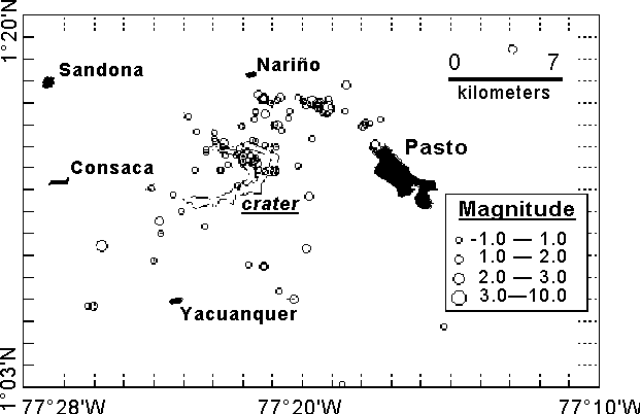Report on Galeras (Colombia) — November 1998
Bulletin of the Global Volcanism Network, vol. 23, no. 11 (November 1998)
Managing Editor: Richard Wunderman.
Galeras (Colombia) Fracture-related seismicity continues
Please cite this report as:
Global Volcanism Program, 1998. Report on Galeras (Colombia) (Wunderman, R., ed.). Bulletin of the Global Volcanism Network, 23:11. Smithsonian Institution. https://doi.org/10.5479/si.GVP.BGVN199811-351080
Galeras
Colombia
1.22°N, 77.37°W; summit elev. 4276 m
All times are local (unless otherwise noted)
Since a volcanic crisis in February 1989 (SEAN 14:02-14:05), Observatorio Vulcanológico y Sismológico de Pasto (OVSP) has been constantly monitoring Galeras. The following is from their bi-monthly reports for late 1998.
During September and October 1998, low-level seismic activity continued at Galeras (figure 90). Most of the energy released (1.6 x 1016 ergs) was due to earthquakes associated with a fracture process. Volcano-tectonic earthquakes registered during these two months totaled 79, ranging from 0.5 to 16 km in depth. One remarkable earthquake occurred at 0209 on 21 September: it was located at 1°15.75'N, 77°19.16'W at a depth of 8 km, released 1.21 x 1016 ergs of energy, and had a coda magnitude of 3.4. This earthquake was felt in Pasto City and neighboring settlements. It was the most energetic event of 1998 to date.
Seismic processes related to fluid dynamics (i.e. long-period events and tremor episodes) released a total of 5.18 x 1014 ergs. Of these events, nine had small amplitudes with long coda and quasi-monochromatic frequencies—so-called "screw type" or "Tornillo" characteristics. Coda values spanned 19-65 s and dominant frequencies ranged 1.82-4.0 Hz. An unusual event occurred 23 October, when harmonic tremor lasted approximately one hour. This episode released 7.09 x 109 ergs.
Galeras, a 4,276 m high andesitic stratovolcano, has a cone that rises 150 m above the floor of the summit caldera. The caldera is open to the west. The active crater is located ~9 km W of Pasto, a city of 350,000 persons. More than 400,000 people live within the volcano's zone of influence. At least six major eruptions have been identified during the past 4,500 years, last in 1886. These eruptions were Vulcanian with inferred low-altitude eruption columns (<10 km) that produced small-volume pyroclastic flows. During the last 500 years eruptions have been characterized by gas-and-ash emissions, small lava flows, and pyroclastic flows that have traveled up to 15 km from the crater.
Geological Summary. Galeras, a stratovolcano with a large breached caldera located immediately west of the city of Pasto, is one of Colombia's most frequently active volcanoes. The dominantly andesitic complex has been active for more than 1 million years, and two major caldera collapse eruptions took place during the late Pleistocene. Long-term extensive hydrothermal alteration has contributed to large-scale edifice collapse on at least three occasions, producing debris avalanches that swept to the west and left a large open caldera inside which the modern cone has been constructed. Major explosive eruptions since the mid-Holocene have produced widespread tephra deposits and pyroclastic flows that swept all but the southern flanks. A central cone slightly lower than the caldera rim has been the site of numerous small-to-moderate eruptions since the time of the Spanish conquistadors.
Information Contacts: Patricia Ponce V., and Pablo Chamorro C., Observatorio Vulcanológico y Sismológico de Pasto (OVSP), Carrera 31, 18-07 Parque Infantil, PO Box 1795, Pasto, Colombia (URL: https://www2.sgc.gov.co/volcanes/index.html).


